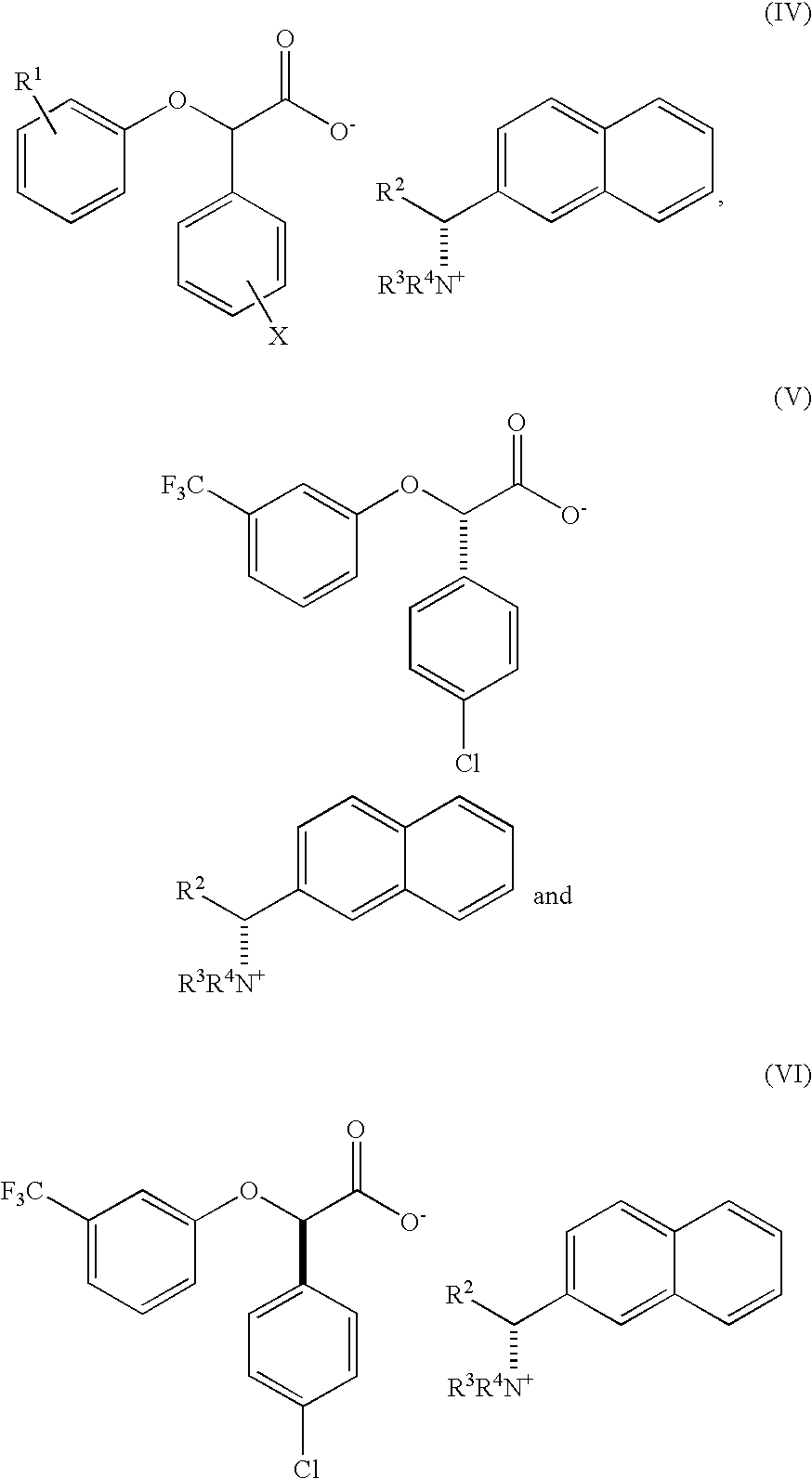Resolution of alpha-(phenoxy) phenylacetic acid derivatives with naphthyl-alkylamines
a technology of naphthylalkylamine and phenylacetic acid, which is applied in the direction of organic racemisation, carboxylic compound preparation, organic chemistry, etc., can solve the problems of drug interaction problems, drug metabolism changes mediated by inhibition of cytochrome p450 enzymes, and high potential to precipitate significant adverse effects in patients
- Summary
- Abstract
- Description
- Claims
- Application Information
AI Technical Summary
Benefits of technology
Problems solved by technology
Method used
Image
Examples
example 1
[0116]This example shows representative results of chiral resolution screening in ethanol using a variety of chiral phenylalkyl amine bases with chiral naphthylalkylamine bases.
[0117]Previous resolution of CPTA has been reported in U.S. patent application Ser. No. 10 / 656,567 and U.S. Pat. No. 6,262,118, in which chiral alkylamine bases were used. The preparation of CPTA is also reported therein.
[0118]This example compares the results of resolving a racemic mixture of CPTA using a variety of different chiral phenyl alkylamine bases with chiral naphthylamine bases to obtain a solid enantiomerically enriched (−)-isomer. The method of the present invention allows the solid enantiomerically enriched (−)-CPTA to be readily isolated from the solution in higher enantiomeric purity.
[0119]Racemic CPTA was prepared by the potassium hydroxide hydrolysis of racemic halofenate. For chiral base screening, equal molar mixtures of chiral base and sodium hydroxide were mixed with two equivalents of C...
example 2
[0121]This example shows the result of resolving racemic CPTA with (S)-(−)-1-(2-naphthyl)-ethylamine.
[0122]The general crystallization procedure was to charge a 150-mL jacketed bottom-drain flask with 20 g (60 mmol) of CPTA and 2.10 g KOH in 80 ml of water and MTBE (1:1) at r.t. To this solution was added 4.66 g (27.3 mmol) of (S)-(−)-1-(2-naphthyl)-ethylamine as its free base. The mixture became clear as the base dissolved, was heated to reflux and then cooled to r.t. to give a slurry. No seeding was required to induce nucleation. The solids were collected by filtration, washed with 60 ml of water and 50 ml of MTBE and dried under vacuum to give 13.3 g (44% yield by mass balance, 88% of theoretical yield) of the CPTA salt (calculated yields are derived from a forced mass balance from the racemic CPTA feed, by knowing the crystal and mother liquor composition of (−)-CPTA and (+)-CPTA). Chiral HPLC analysis found 2.0 and 98.0 area % of (+) and (−)-CPTA, respectively, in the solid pha...
example 3
[0124]This example shows a method for separating (−)-CPTA from the (S)-(−)-1-(2-naphthyl)-ethyl amine.
[0125]To separate (−)-CPTA from (S)-(−)-1-(2-naphthyl)-ethylamine, the diastereomeric salt is mixed with 1,2-dichloroethane, and aqueous hydrochloric acid is added to give a pH in the aqueous phase of less than about 2. After complete dissolution of the solid, the aqueous phase containing the hydrochloride salt of (S)-(−)-1-(2-naphthyl)-ethylamine is separated. After a water wash of the organic phase, the bulk of the 1,2-dichloroethane is removed by distillation to remove residual water. The pH of the combined aqueous phase was 0.9. HPLC assay of the organic phase found 99.8% of theory of (−)-CPTA as a solution in 1,2-dichloroethane. Complete solvent removal gave an oil.
PUM
| Property | Measurement | Unit |
|---|---|---|
| optical purity | aaaaa | aaaaa |
| optical purity | aaaaa | aaaaa |
| optical purity | aaaaa | aaaaa |
Abstract
Description
Claims
Application Information
 Login to View More
Login to View More - R&D
- Intellectual Property
- Life Sciences
- Materials
- Tech Scout
- Unparalleled Data Quality
- Higher Quality Content
- 60% Fewer Hallucinations
Browse by: Latest US Patents, China's latest patents, Technical Efficacy Thesaurus, Application Domain, Technology Topic, Popular Technical Reports.
© 2025 PatSnap. All rights reserved.Legal|Privacy policy|Modern Slavery Act Transparency Statement|Sitemap|About US| Contact US: help@patsnap.com



